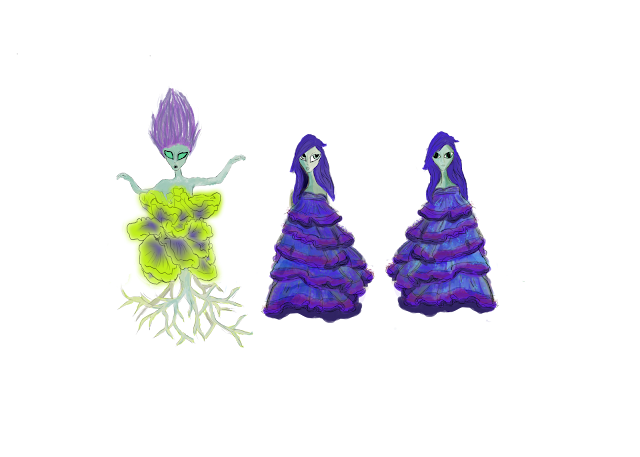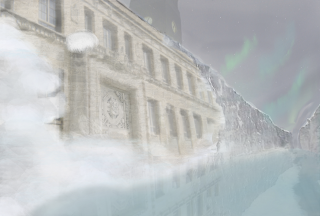ARTS 325 Digital Painting 2012
Friday, December 2, 2016
Wednesday, January 2, 2013
Saturday, May 26, 2012
Thank you for a good semester
Thanks for a good semester, and good luck next fall with new courses here, or wherever you may be and whatever you may be doing after graduation. Please feel free to email me with new work or news of your creative life. Remember Gnomon videos and subscribing to Lynda.com if you want to learn more, and remember to intentionally fight for personal creative time to continue develop your creativity. Try working without deadlines, and working until the work is just exactly what you want. No one knows how long you worked, they only know what you created. You can use the 80% rule when judging others (ie let it go), but the 110% rule when judging your own work. This is easier when you give yourself - take for yourself - the time for iterations, polishing, redoing after new inspration, throwing out, putting in, rethinking, refeeling, reknowing. Save flattened copies along the way. Good luck on your continuing creative evolution.
I will have the work at the Village in my office. And I have the work from the VIST show there too. But I am gone to Berkeley CA for the summer. If you are near there during June and July, send me an email at marysaslow@gmail.com and we can meet for lunch. What will I be doing there? Art!
I will have the work at the Village in my office. And I have the work from the VIST show there too. But I am gone to Berkeley CA for the summer. If you are near there during June and July, send me an email at marysaslow@gmail.com and we can meet for lunch. What will I be doing there? Art!
Monday, May 14, 2012
FINAL
1.
Paul Debevec
He is head of the graphics
laboratory at the institute of creative technologies. He talked about the
progression of making 3d things look fake to making it look real and believable
and how they have developed technology to make facial 3d models look believable
and crossing the uncanny valley in particular Avatar and spider man.
2.
Tim Fields
He talked about the gaming industry and how
its being fragmented out in that there are more opportunities for people to
become a part of it. How different platforms are making it easier for more
freelance people to work on new games.
3.
Blue Sky
Talked about how they were able to get
light to interact with clouds in an effective and cheap render wise. Developed
a cloud generator and created a library with different seeds. Having a team of
a few people working on specific things.
Gnomon Tutorials
Lighting with Materials:
It was very useful in that it helped me
learn more about shading and how to apply to a 3d model. The artist who made
the tutorial was very good at explaining how to make the material and how
lighting and shading should be applied.
Maya fluid tutorial
The artist Wayne Hollingsworth gave a very
good tutorial on how to create believable fire. The tutorial taught me how to
add texture to the Maya fluids and using the dynamic fields to make a smoke
bomb effect. It also gave a good explanation on how to create oil and wispy
smoke as well as how to create ground dust.


Sunday, May 13, 2012
final post
The two Gnomon videos that I tried to watch but couldnt because my computer would not let me watch them. Were speed painting to matte painting with Rainart and Speedpainting to concept art by David Levy. Above are some things that I made by pulling the brushes from the dvds. In addition to my Final which is a snippet from characterizing the show Party down.
My two talks were Andrew Ellis Johnson and Hooper Turner. Both of them were particularly interesting. Andrew was very political. What I got from his work was a very comical approach. He also
pointed me to a group called improve everywhere.
Hooper Turner told me that I was a performance artist when I spoke with him one on one. He pointed me to artists that I should look up. Tom Sachs, Thomas Demand, Francis Bacon, Irving Norman, Sigmar Polke, Gerhard Richter, Thomas Hirshhorn, Eves Kline, Olive Harring, Katy Smither, etc.. Very nice dude. Gave me his day in New York and how he manages painting and working. Very inspiring.
My two talks were Andrew Ellis Johnson and Hooper Turner. Both of them were particularly interesting. Andrew was very political. What I got from his work was a very comical approach. He also
pointed me to a group called improve everywhere.
Hooper Turner told me that I was a performance artist when I spoke with him one on one. He pointed me to artists that I should look up. Tom Sachs, Thomas Demand, Francis Bacon, Irving Norman, Sigmar Polke, Gerhard Richter, Thomas Hirshhorn, Eves Kline, Olive Harring, Katy Smither, etc.. Very nice dude. Gave me his day in New York and how he manages painting and working. Very inspiring.
That's about it.
Talks and Videos
Mary,
Last week I burned a cd of my paintings and slipped it under the door to your office, I hope you found it!
Talks:
Blue Sky
Blue sky talked about their method for creating clouds. There was so much technical work involved, it was a bit difficult for me to follow. I thought the results they showed from Rio were beautiful, and I was really impressed by the complexity of their process.
Electronic Arts
Electronic Arts talked about what it takes to be a TA at their company. It seems like this position required a lot of technical skills, but very little art. Personally, their talk just confirmed my lack of interested in the gaming industry.
Pixar
Pixar actually begun by talking about their facilities in California, which really gave a feel for how fun it would be to work there. Then they got into the work they did on Cars2, really getting into the process it takes to get a final shot. It was interesting to see how the shots progressed with each step- from story all the way to final lighting. After their talk, I wanted to watch a few Pixar movies so I could really appreciate how amazing the final product is.
Gnomon Videos:
Creature Design Illustration- Nick Pugh
In this video he takes one of his creature drawings and paints it in Photoshop. He used a picture of his daughter to use for his color palette. Using the color-picker, he takes color directly from the photograph begins to block in color on the creature drawing. After he achieves the tones he likes, he reduces the opacity on the brush and begins to detail and blend-in the drawing. The reason he uses this method of color-picking, is to render believable lighting and color on his creature.
How to Draw Cars- Scott Robertson
This video is essentially how to draw cars in different perspectives. In this lesson he refers back to one of his older videos on basic perspective drawing, and applying those skills to draw cars. When he draws cars, he begins by drawing ellipsis (the tires) and creates references and guidelines to begin drawing the proportions of the car...It's been a while since I've done a technical drawing, so this video was a fun way of brushing up on doing rough drawings in perspective.
Saturday, May 12, 2012
Andrew Ellis Johnson - I had a class with him, and he had us bring in images and interrogate them, it was very interesting to dissect pictures and try to come up with every possible reason for every single part of the image, from the color, to the text. The thing that stood out to me most about his art was that he used this idea or concept of interruption. The entire time during his lecture there was the sound of a goat in the background, and it was constantly making noise and disrupting the talk, so it was hard to concentrate at times on his speech that he was giving. The point however was to decide what was important, the goat interruption or the words in which he was speaking. His art is very bizarre and if you are not highly educated or know the background of his art, many of the symbols and purposely used physical pieces are not understood, and the whole of many of his pieces are completely confusing.
Leah Duncan- Leah was much more abstract, and did many large scale projects. She likes to reach as much tension on a 2d surface as possible, she draws inspiration from Matisse and Picasso. Especially Picasso because he ignored perspective and painted loosely and confidently. It was interesting to hear her say that you should concentrate on what you want from a painting and then not try to clean it up or perfect it if the idea is already visible and understood.
Thecla Schiphorst
My favorite of hers was a Dream Machine that her and a grad student had worked on. It showed a computer taking in images throughout the day of different places and then had a display as if the machine was sleeping and based off of the images it had seen that day connections were made and a series of images or short movies were played as the "dream". And she talked a lot about de-habituation which can re-tune thoughts and thought processes, which I found very interesting.
Leah Duncan- Leah was much more abstract, and did many large scale projects. She likes to reach as much tension on a 2d surface as possible, she draws inspiration from Matisse and Picasso. Especially Picasso because he ignored perspective and painted loosely and confidently. It was interesting to hear her say that you should concentrate on what you want from a painting and then not try to clean it up or perfect it if the idea is already visible and understood.
Thecla Schiphorst
My favorite of hers was a Dream Machine that her and a grad student had worked on. It showed a computer taking in images throughout the day of different places and then had a display as if the machine was sleeping and based off of the images it had seen that day connections were made and a series of images or short movies were played as the "dream". And she talked a lot about de-habituation which can re-tune thoughts and thought processes, which I found very interesting.
Subscribe to:
Posts (Atom)







